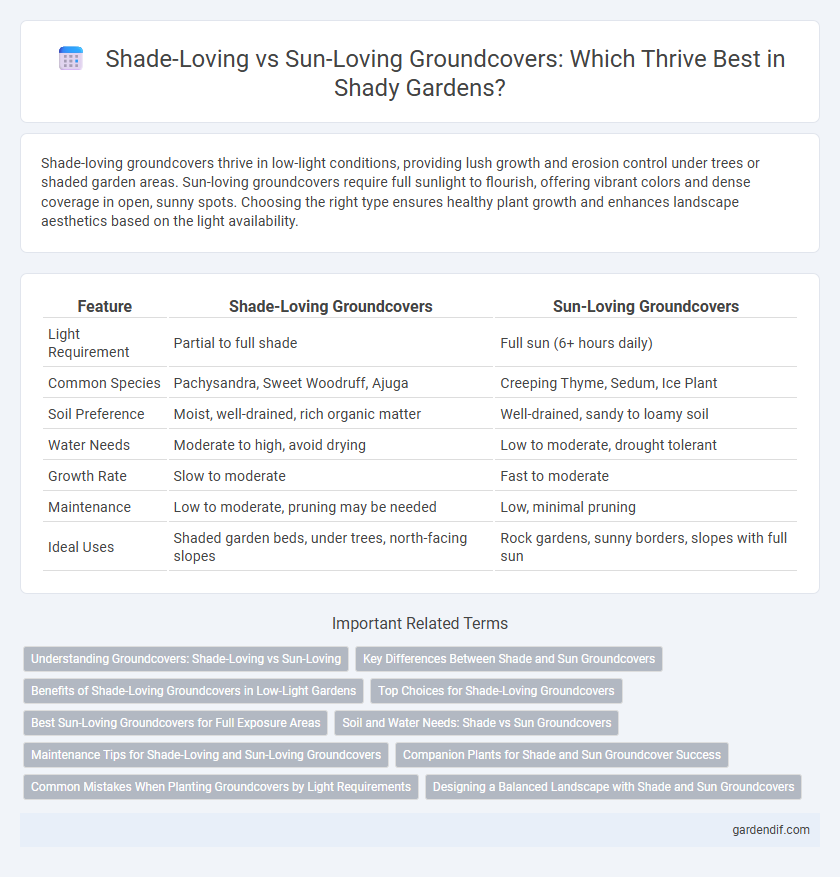
shade-loving groundcovers vs sun-loving groundcovers Illustration
Shade-loving groundcovers thrive in low-light conditions, providing lush growth and erosion control under trees or shaded garden areas. Sun-loving groundcovers require full sunlight to flourish, offering vibrant colors and dense coverage in open, sunny spots. Choosing the right type ensures healthy plant growth and enhances landscape aesthetics based on the light availability.
Table of Comparison
| Feature | Shade-Loving Groundcovers | Sun-Loving Groundcovers |
|---|---|---|
| Light Requirement | Partial to full shade | Full sun (6+ hours daily) |
| Common Species | Pachysandra, Sweet Woodruff, Ajuga | Creeping Thyme, Sedum, Ice Plant |
| Soil Preference | Moist, well-drained, rich organic matter | Well-drained, sandy to loamy soil |
| Water Needs | Moderate to high, avoid drying | Low to moderate, drought tolerant |
| Growth Rate | Slow to moderate | Fast to moderate |
| Maintenance | Low to moderate, pruning may be needed | Low, minimal pruning |
| Ideal Uses | Shaded garden beds, under trees, north-facing slopes | Rock gardens, sunny borders, slopes with full sun |
Understanding Groundcovers: Shade-Loving vs Sun-Loving
Shade-loving groundcovers such as Pachysandra, Vinca minor, and Lamium thrive in low-light environments by adapting to limited sunlight and maintaining vibrant foliage. Sun-loving groundcovers like creeping thyme, sedum, and creeping phlox require full sun exposure to maximize photosynthesis and promote flowering, often demonstrating drought tolerance. Selecting the right groundcover based on light availability enhances soil protection, reduces erosion, and supports ecosystem health.
Key Differences Between Shade and Sun Groundcovers
Shade-loving groundcovers typically have larger, thinner leaves to capture limited light and thrive in moist, cooler environments, whereas sun-loving groundcovers possess smaller, thicker leaves to minimize water loss and tolerate intense sunlight and heat. Shade groundcovers often require rich, well-drained soil with consistent moisture, while sun-loving varieties adapt to drier, nutrient-poor soils and more variable conditions. Growth rates and flowering patterns also differ, with sun-loving groundcovers usually exhibiting more vigorous growth and abundant blooms compared to the more subdued flowering of shade-adapted species.
Benefits of Shade-Loving Groundcovers in Low-Light Gardens
Shade-loving groundcovers such as Pachysandra, Vinca minor, and Lamium thrive in low-light gardens, providing excellent soil erosion control and weed suppression where sun-loving varieties struggle. These plants conserve moisture and reduce soil temperature by creating a dense carpet of foliage, improving overall garden health without requiring intense sunlight. Their adaptability to shaded environments supports biodiversity and enhances aesthetic appeal in areas with limited direct sunlight.
Top Choices for Shade-Loving Groundcovers
Top choices for shade-loving groundcovers include pachysandra, ajuga, and sweet woodruff, which thrive in low-light conditions and provide vibrant foliage textures. These plants tolerate dense shade while suppressing weeds and stabilizing soil, making them ideal for shaded garden areas. In contrast, sun-loving groundcovers like creeping thyme and sedum require full sunlight and dry conditions to flourish.
Best Sun-Loving Groundcovers for Full Exposure Areas
Sun-loving groundcovers such as creeping thyme, sedum, and creeping phlox thrive in full exposure areas by tolerating intense sunlight and heat. These plants provide excellent soil coverage, reduce erosion, and add vibrant colors with their flowers and foliage. Choosing drought-resistant varieties like ice plant or ajuga ensures sustained growth and minimal maintenance in sun-drenched landscapes.
Soil and Water Needs: Shade vs Sun Groundcovers
Shade-loving groundcovers typically require moist, well-drained soil rich in organic matter to thrive, as they receive less direct sunlight, which reduces evaporation and conserves soil moisture. In contrast, sun-loving groundcovers demand soil with good drainage but tolerate drier conditions due to increased evaporation under full sunlight. Proper irrigation management tailored to the specific water retention and sunlight exposure of shade or sun environments ensures optimal growth and groundcover health.
Maintenance Tips for Shade-Loving and Sun-Loving Groundcovers
Shade-loving groundcovers such as pachysandra and hostas require regular mulching to retain moisture and prevent weed growth, alongside consistent watering to thrive in low-light conditions. In contrast, sun-loving groundcovers like creeping thyme and sedum demand well-drained soil and minimal watering once established, with occasional pruning to promote healthy growth. Proper maintenance tailored to these specific environmental needs ensures optimal groundcover health and aesthetic appeal.
Companion Plants for Shade and Sun Groundcover Success
Shade-loving groundcovers such as creeping thyme, ajuga, and pachysandra thrive in low-light environments by forming dense mats that suppress weeds and retain soil moisture. Sun-loving groundcovers like creeping phlox, sedum, and ice plant require full sunlight to maximize photosynthesis and provide vibrant blooms that attract pollinators. Selecting appropriate companion plants based on light conditions enhances groundcover success by improving soil health, preventing erosion, and promoting a balanced ecosystem.
Common Mistakes When Planting Groundcovers by Light Requirements
Planting shade-loving groundcovers in full sun often leads to leaf scorch, poor growth, and premature plant death, while sun-loving groundcovers placed in dense shade exhibit weak, leggy foliage and reduced flowering. Selecting groundcovers based on accurate light requirements ensures optimal photosynthesis, root development, and overall plant health. Failing to consider specific species' sunlight tolerance commonly results in costly replacements and compromised garden aesthetics.
Designing a Balanced Landscape with Shade and Sun Groundcovers
Selecting shade-loving groundcovers such as Pachysandra or Vinca minor alongside sun-loving varieties like creeping thyme or sedum creates a balanced landscape that thrives in varying light conditions. Incorporating both types ensures year-round coverage, reduces soil erosion, and enhances biodiversity by supporting diverse plant species. Proper zoning based on sunlight exposure optimizes growth, aesthetic appeal, and maintenance efficiency in residential or commercial garden designs.
shade-loving groundcovers vs sun-loving groundcovers Infographic

 gardendif.com
gardendif.com